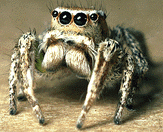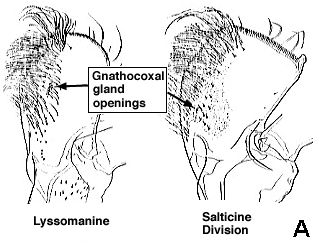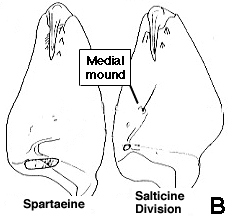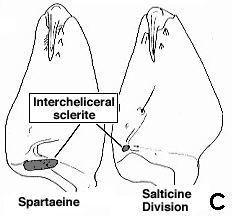Salticidae
Jumping Spiders
Wayne Maddison


This tree diagram shows the relationships between several groups of organisms.
The root of the current tree connects the organisms featured in this tree to their containing group and the rest of the Tree of Life. The basal branching point in the tree represents the ancestor of the other groups in the tree. This ancestor diversified over time into several descendent subgroups, which are represented as internal nodes and terminal taxa to the right.

You can click on the root to travel down the Tree of Life all the way to the root of all Life, and you can click on the names of descendent subgroups to travel up the Tree of Life all the way to individual species.
For more information on ToL tree formatting, please see Interpreting the Tree or Classification. To learn more about phylogenetic trees, please visit our Phylogenetic Biology pages.
close boxIntroduction
Jumping spiders (Salticidae) are easily distinguished from other spiders by their four big eyes on the face and four smaller eyes on top of the head. Around the world there are probably more than 5000 species of jumping spiders.
Jumping spiders are charming spiders that look up and watch you. Their excellent vision allows them to hunt much as do cats, spotting prey from long distances, creeping up then pouncing using their jumping ability. Although a jumping spider can jump more than thirty times its body length, none of its legs has enlarged muscles. The power for jumping probably comes from a quick contraction of muscles in the front part of the body increasing the blood pressure, which causes the legs to extend rapidly much as in the toy frogs that hop when you squeeze a bulb.
Their vision also allows communications by visual means, such as the elaborate courtship dances that males perform.
Salticids are perhaps as old and diverse as mammals, though not many humans know their world. Many salticids are colorful, they take on a variety of body forms, and some have disguises, looking like ants and other organisms. The bright colors and elaborate forms of some jumping spider species are involved in courtship.
If you'd like to learn more about jumping spiders, you can follow the phylogenetic tree above to explore the diversity of species. You might also want to wander through a gallery of jumping spider images and movies, explore their anatomy, or focus on the jumping spiders of America north of Mexico.
Characteristics
The monophyly of the family Salticidae is best supported by the peculiar eye structure yielding excellent vision and corresponding vision-based behavior. In particular, the AME are enlarged and tube shaped, with the retina strip-shaped and tiered (Scheuring, 1914; Land, 1969, Blest and Sigmund, 1984). Each of these features may be cited as a synapomorphy uniting the salticids. The fully-developed system of eye muscles described by Scheuring (1914) appears unique to salticids, though eye muscles are inadequately studied among salticids and spiders as a whole. Study of the eye muscles of thomisids and clubionids could be particularly important in establishing a sister group to salticids. The complex branching of the intestinal diverticula over the brain of salticids (Millot, 1931) may also delimit the family, though there have not been studies of the diverticula of lyssomanines, whose narrower ocular area may not accommodate complex diverticula.
Salticid faunas of geographical areas
By navigating along the tree above, you can wander through jumping spider diversity throughout the world (although, at present, the coverage is highly biased towards New World salticids). Guides or overviews to the salticid faunas of the following restricted geographical areas are available:
- America North of Mexico

- Ecuador, South America

Discussion of Phylogenetic Relationships
The phylogeny of salticids is poorly resolved. What is shown above is provisional and incomplete, based on the work of Maddison (1988, 1996).
Of the branches shown here, the best supported clade is the Salticine Division. Some synapomorphies for the Salticine Division are:
- Short, anteriorly placed fovea (Wanless, 1984);
- Small posterior median eyes (Wanless, 1984);
- Cell bodies of anterior lateral eye photoreceptors displaced to side (Blest, 1983);
- AME retinal strip sharply curved (Blest and Sigmund, 1984);
- Six arms of pigmented glia surround secondary eye photoreceptors, as opposed to 4 or less in Lyssomanes and the spartaeines (Eakin and Brandenburger, 1971; Blest and Sigmund, 1984).
Maddison (1988, 1996) added the following additional synapomorphies:
- Absence (or great reduction) of tarsal claw on female palpus;
- Gnathocoxal gland openings displaced medially (A);
- Posterior tarsal claws with far fewer teeth than anterior;
- Accumulation of slit sense organs and associated seta on a mound on the medial edge of the basal segment of the chelicerae (B);
- Intercheliceral sclerite small (C).
The unidentates form a group recognized by Simon that may retain validity, if fissidents are included as a variant. The dendryphantines, euophryines and several smaller subfamilies make up the "free-embolus" group, which have a movable embolus separated from the tegulum by an inflatable hematodocha, and an embolus that curls counterclockwise from origin to tip in the left palpus ventral view.
Express routes
The salticid section of the Tree of Life is most completely developed in the following areas:
- Habronattus: A remarkable genus whose males are elaborately colored and ornamented. You will find videos of their courtship behavior.
- Pelegrina: Some of the illustrations and diagnoses from the monograph of Pelegrina (Maddison, 1996) are shown here.
References
Proszynski's Catalogue has many more salticid references.
Blest A.D. 1983. Ultrastructure of secondary retinae of primitive and advanced jumping spiders (Araneae, Salticidae). Zoomorphology, 102 (2): 125-141.
Blest, A. D. and C. Sigmund. 1984. Retinal mosaics of the principal eyes of two primitive jumping spiders, Yaginumanis and Lyssomanes: clues to the evolution of Salticid vision. Proceedings of the Royal Society of London B 221: 111-125.
Eakin, R. M. and J. L. Brandenburger. 1971. Fine structure of the eyes of jumping spiders. Journal of Ultrastructure Research 37: 616-663.
Land, M. F. 1969. Structure of the retinae of the principal eyes of jumping spiders (Salticidae: Dendryphantinae) in relation to visual optics. Journal of Experimental Biology 51: 443-470.
Maddison, W.P. 1988. A revision of jumping spider species groups formerly placed in the genus Metaphidippus, with a discussion of salticid phylogeny (Araneae). PhD. thesis, Harvard University.
Maddison, W.P. 1996. Pelegrina Franganillo and other jumping spiders formerly placed in the genus Metaphidippus (Araneae: Salticidae). Bulletin of the Museum of Comparative Zoology. l54(4): 215-368.
Millot, J. 1931. Les diverticules intestinaux du cephalothorax chez les araignees vraies. Zeitschrift für Morphologie und Ökologie der Tiere 21: 740-764.
Scheuring, L. 1914. Die Augen der Arachnoideen. II. Zool. Jahrb., Anat. 37: 369-464.
Wanless, F.R. 1984. A review of the spider subfamily Spartaeinae nom. n. (Araneae: Salticidae) with descriptions of six new genera. Bull. Br. Mus. nat. Hist. (Zool.) 46(2): 135-205.
Information on the Internet
- Proszynski's Catalogue of Salticidae.
This catalogue is a complete taxonomic catalogue of salticids as of early 1995. It also includes an extensive references section.
Title Illustrations

This is an apparently undescribed species of Habronattus, near H. hirsutus, from California.
Images and text on this page and other pages in the salticid section of the Tree of Life are © copyright 1994-1995 W. Maddison unless otherwise noted, and are not to be used without permission.
| Copyright |
© 1994-1995 Wayne Maddison

|
|---|
About This Page
Wayne Maddison

University of British Columbia, Vancouver, British Columbia, Canada
Correspondence regarding this page should be directed to Wayne Maddison at
Page copyright © 2011 Wayne Maddison
All Rights Reserved.
- Content changed 12 October 2011
Citing this page:
Maddison, Wayne. 2011. Salticidae. Jumping Spiders. Version 12 October 2011 (under construction). http://tolweb.org/Salticidae/2677/2011.10.12 in The Tree of Life Web Project, http://tolweb.org/










 Go to quick links
Go to quick search
Go to navigation for this section of the ToL site
Go to detailed links for the ToL site
Go to quick links
Go to quick search
Go to navigation for this section of the ToL site
Go to detailed links for the ToL site